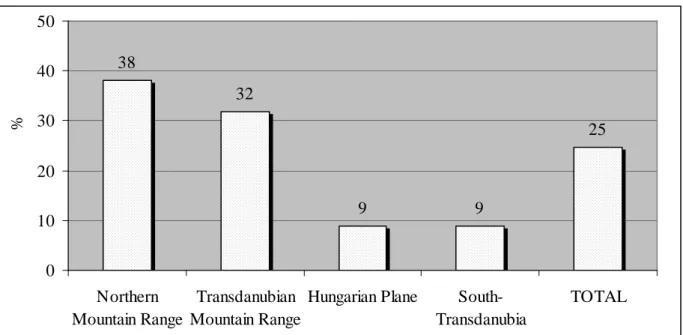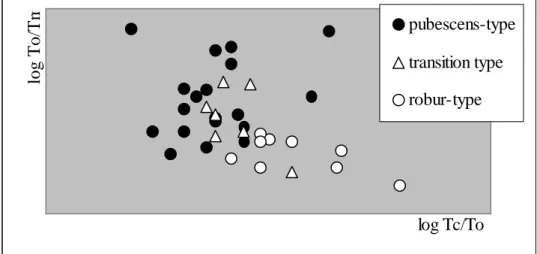1. Introduction
The objective of my research was the following:
1. Elaborating taxonomical methods for the investigation of the variation in the pubescent oak.
2. Giving an overview of the distribution and habitats of pubescent oak in Hungary.
3. Investigating the variation of pubescent oak in Hungary. Research on the variation along geographical and ecological gradients.
4. Examining the potential reasons of the variation.
5. Elaborating suggestions for the forestry and nature conservation management of the species based on the results of the previous points.
The list of the completed investigations is the following:
1. Preparation of the distribution map of the pubescent oak in Hungary based on the data of scientific publications, material of herbaria and the Data bank of the National Forest Inventory Service.
2. Analysis of micromorphological features (stomata and trichome types) by means of scanning electron microscopy (SEM) and stereo microscopy.
3. Analysis of macromorphological features by multivariate methods (principal component analysis, hierarchical clustering, Fourier analysis combined by discriminant analysis.
4. Chemotaxonomy: Research of variation in flavonoides by overpressured layer cromatography (OPLC).
5. Analysis of cpDNA variation. As a part of the international program on the cpDNA haplotype mapping of the European oak species I completed tasks in the Hungarian subproject.
The hybridization of Q. pubescens and a Q. robur is questioned by several Western-European researchers, at the same time the process plays an important role in the domestic forest-steppe associations not only in the literature but also according to my former research. To prove the hypothesis I completed micro- and macromorphological and chemotaxonomical analysis.
2. Results of the micromorphological investigations
2.1. Examination of trichome types by stereo microscopy.
Trichomes of leaves and shoots were examined of 77 stands representing the distribution and the habitats of pubescent oak in Hungary from a total of 586 Quercus pubescens trees. The most important results are as follows.
• The micromorphological variation of Q. pubescens populations in Hungary is similar to the populations in the mediterranean region.
• The introgressive hybridization between Q. pubescens and Q. petraea in the Hungarian Mountain Range is much higher than formerly presumed (figure 1).
Figure 1: Frequency of samples with stellate trichomes on the abaxial surface of the leaf lamina (petrae-type) in the flora-regions of Hungary
• In the South-Transdanubian populations the proportion of samples with stellate trichomes is much below the national avarage. This can be explained by the fact that the frequency of submediterranean precipitation type increases southwards.
• The proportion of samples with stellate trichomes is low in the samples from the Great Hungarian Plain, as well. At the same time, the variety of pilosity-types is the highest in this region. This can be explained by the absence of Q. petraea in most of these stands, while transition forms between Q. pubescens and Q. robur appear in the populations.
• The introgressive hybridization contributes to the remarkable variety of Q. pubescens.In the Hungarian Mountain Range the rate of the transition forms between Q. pubescens and Q. petraea is significantly higher on soil related to non-calcareous stone than on soil related to calcareous stone (figure 2). We can establish that the extremely dry and acidic sites are favourable for hybridization, consequently that the introgression between the species plays an important role in their ecological adaptation.
38
32
9 9
25
0 10 20 30 40 50
Northern Mountain Range
Transdanubian Mountain Range
Hungarian Plane South- Transdanubia
TOTAL
%
Figure 2: Frequency of samples with stellate trichomes on the abaxial surface of the leaf lamina (petrae-type) on calcareous and non-calcareous sites in the hill regions of Hungary
2.2 Analysing micromorphological features by means of scanning electron mikroscope (SEM) observation
• On the basis of SEM investigations on the same sample trees in different times we can establish that the features of stomata change in the vegetation period. We should be critical about former descriptions of the stomata-types of Q. pubescens, Q. robur and Q. petraea. To decide whether the stomatal rim is covered by wax scales we have to collect samples in different times.
• The observation of trichome types and stomata types together seems to be useful for the purpose of detecting the hybrids of Q. pubescens and the closly related oak species (Q. petraea and Q.
robur). Trees occur having both intermediate micro- and macromorphological features in the sympatric populations of Q. pubescens WILLD. and Q. robur L. on the Great Hungarian Plain and on its fringes.
3. Results of macromorphological investigations
3.1. Investigations on the differentiation of the two supposed species, Qu. virgiliana Ten. and Qu. pubescens s. str., by means of multivariate methods (principal components analysis, hierarchical clustering).
Ten macromorphological features of the leaves and fruits of 97 sample trees were analysed.
• Present research could not prove the differentiation of the two pubescent oak species.
3.2. Investigation on the role of introgressive hybridisation between Q. pubescens and Q. robur by means of Fourier analysis and discriminant analysis. A total of 125 samples were collected in sympatric populations of Q. pubescens and Q. robur on the Great Hungarian Plain and on its fringes. The Fourier analysis of every leaf resulted in a set of 60 numbers, which characterise the shape of the different leaves. We compared these 125 sets by means of discriminant analysis. We completed the a priori groupping of the objects using the determination key of trichome-types developed by AAS.
• The analysis confirmed the role of introgressive hybridization between Q. pubescens and Q.
robur.
23
28
7
23 55
47
40
53
0 10 20 30 40 50 60
Northern Mountain Range
Transdanubian Mountain Range
South- Transdanubia
TOTAL
%
calcareous stone non-calcareous stone
4. Results of the chemotaxonomical investigations
Variation in flavonoides was examined by overpressured layer cromatography (OPLC) in the leaves collected from 38 sample trees of a sympatric population of Q. pubescens and Q. robur.
• There is no qualitaive difference in the flavonoid composition of the two species, only a quantitative one.
• There is a strict correlation between the result of the chemotaxonomical investigations and the a priori groupping of trichome-types. (figure 3.)
Figure 3: Result of the OPLC.
To, Tm, Tc signify the areas under the peaks O, M and C of the densitogram
• The analysis confirmed the role of introgressive hybridization between Q. pubescens and Q.
robur.
• The method proved to be fast, easy-to-reproduce and very economical.
5. Analysis of cpDNA variation
In the framework of the international program on the cpDNA haplotype-mapping of the European oak species the most important results relating to Quercus pubescens are as follows:
• The domestic Quercus pubescens samples belong to 6 cpDNA haplotypes.
• The present domesic oak species recolonised Hungary from the refugia in the Balkans and the Italian penninsula.
6. Practical utilization of the results
• It was found that the introgression between the species plays an important role in their ecological adaptation. Based on these findings the only acceptable method in the close-to-nature forest management is natural regeneration.
• Measures have to be taken to save the ecotypes of the Quercus pubescens in the Great Hungarian Plain with special attention to the transition forms between Quercus pubescens and Quercus robur.
log Tc/To
log To/Tm
pubescens-type transition type robur-type
7. Relevant publications
BORDÁCS S. BOROVICS A. KÉZDY P. (1998): A molyhos tölgyek. In: BACH I.–BORDÁCS S.– MÁTYÁS CS. (szerk.): Az erdei fás növények génmegırzési alapelveinek kidolgozása (Az erdészeti genetikai erıforrások megırzése c. nemzeti program vázlata). – Budapest.
KÉZDY P. – BORDÁCS S. (1998): Az olasz tölgy (Quercus virgiliana Ten.) ökológiai szerepe és jelentısége a magyar erdıgazdálkodásban. – Erdészeti Lapok 83 (1): 15-17.
BOROVICS A.–KÉZDY P.–SZMORAD F. (1999): Magyar tölgy (Quercus frainetto Ten.) In: Bartha D. –Bölöni J. – Király G. (szerk.): Magyarország ritka fa- és cserjefajai I. – Tilia 7: 48-54.
BORDÁCS S.–BOROVICS A.–KÉZDY P. (1999): A molyhos tölgyek - Quercus pubescens (incl.
Quercus virgiliana) génmegırzése. In: BACH I.–BORDÁCS S.–MÁTYÁS CS. (szerk.):
Genetikailag veszélyeztetett, ritka fafajok génmegırzésének gyakorlati teendıi. – Budapest. pp.:
25-32.
KÉZDY P.(2000): Taxonómiai kérdések a tölgykutatásban. – Erdészeti Lapok 135 (5): 134-136.
KÉZDY P. (2000): Natural hybridization in sympatric populations of Quercus pubescens Willd. and Q. robur L. – A Kertészeti és Élelmiszeripari Egyetem Közleményei 59: 99-104.
CSAIKL,U.–BORDÁCS S.–BOROVICS A.–KÉZDY P.–POPESCU,F.–SLADE,D.–GRACAN,J.– BURG,K. (2000): Chloroplast DNA variation in Central Europe. – Forest Ecology and Management (megj. alatt).
KÉZDY P. (2001): Taxonómiai vizsgálatok a hazai molyhos tölgy alakkörön (Quercus pubescens s.
l.) mikromorfológiai bélyegek segítségével. – Kitaibelia (megj. alatt).
Conference presentations and posters
KÉZDY P. (1997): Morphological Diversity and the Differentation of Pubescent Oaks (Quercus virgiliana Ten. and Qu. pubescens Willd.) in Hungary. - Diversity and Adaptation in Oak Species. Proceedings of the second meeting of Working Party 2.08.05, Genetics of Quercus, of the IUFRO. State College, Pennsylvania, USA. 1997. október 12.-17.
KÉZDY P. (1997): Molyhos tölgyek (Quercus pubescens Willd. és Qu. virgiliana Ten.) ökológiai és taxonómiai összefüggései. – Magyar Ökológus Kongresszus, Elıadások és poszterek összefoglalói. Pécs. 1997. június 26-29.
KÉZDY P. (1997): A molyhos tölgyek taxonómiai problémái a Kárpát-medencében. – Dendrológiai kutatások a Kárpát-medencében – Tudományos tanácskozás Fekete Lajos születésének 160.
évfordulóján. 1997. december 3.
KÉZDY P.–DOBAY G.–KUN A. (1999): Alföldi és alföld-peremi molyhos tölgy elıfordulások. – Aktuális flóra- és vegetációkutatások Magyarországon III., Szombathely.
Manuscripts
KÉZDY P. (1998): A hazai molyhos tölgyes növénytársulások. – Szigorlati dolgozat, Soproni Egyetem, Sopron. (mscr.)


